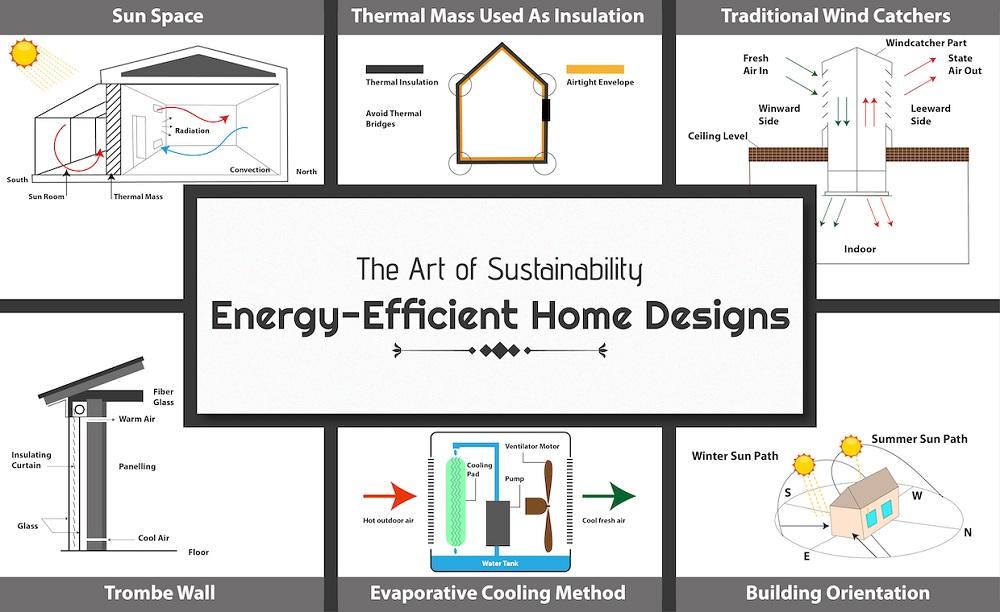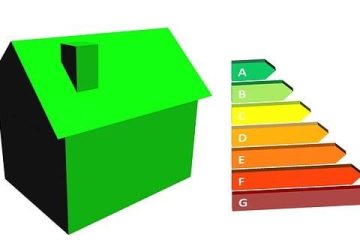Table of Contents
- Understanding the Principles of Energy Efficient Design
- Innovative Technologies Transforming Building Energy Use
- Maximizing Natural Light for Sustainable Living Spaces
- Practical Steps to Boost Energy Efficiency in Existing Structures
- The Role of Building Materials in Energy Conservation
- Q&A
- The Way Forward


Understanding the Principles of Energy Efficient Design
Energy-efficient design is grounded in several key principles that prioritize sustainability while maximizing comfort and utility for occupants. One fundamental aspect is the integration of natural light into building designs. By strategically positioning windows and utilizing skylights, architects can reduce reliance on artificial lighting, enhancing the ambiance and reducing energy costs. Coupled with light-reflecting materials for surfaces, the effectiveness of natural light can be amplified significantly, leading to a more welcoming environment.
Another core principle revolves around thermal performance. Buildings can be designed to minimize energy loss through proper insulation and thermal mass. High-performance insulation materials can drastically cut down heat transfer, thereby maintaining a consistent indoor temperature. In addition, the orientation of the building can optimize solar gain in colder months while providing shade during the summer, creating a balanced thermal environment year-round. Lessons from passive solar design techniques can inform these choices, reminding us that thoughtful positioning can yield significant energy savings.
the selection of sustainable materials plays a pivotal role in energy efficiency. By choosing locally sourced, renewable, or recycled materials, designers not only lessen the environmental impact but also reduce the carbon footprint associated with transporting materials. Strategies include utilizing bamboo, which is rapidly renewable, or recycled steel that requires less energy to produce compared to new steel. This approach to material selection, combined with modern technologies and smart design, enables the creation of buildings that are not only energy-efficient but also contribute positively to the environment.


Innovative Technologies Transforming Building Energy Use
As building energy consumption continues to rise, innovative technologies are stepping in to significantly enhance energy efficiency. One of the most influential advancements is the integration of smart building systems. These systems use real-time data and advanced algorithms to optimize energy use based on occupancy patterns, weather conditions, and even time of day. Key features often include:
- Automated lighting controls that adjust based on natural light levels or occupancy.
- HVAC optimization systems that adapt heating and cooling according to usage data.
- Energy management software that allows building managers to monitor and manage energy consumption remotely.
Another groundbreaking development in building energy efficiency is renewable energy integration. Solar panels, wind turbines, and geothermal systems are becoming increasingly viable options for powering buildings. By harnessing these renewable resources, structures not only reduce their carbon footprint but also save on energy costs in the long run. Key components of this approach include:
- On-site generation through solar photovoltaic (PV) panels.
- Battery storage systems that store excess energy for later use.
- Energy-efficient insulation that reduces heating and cooling demands.
Lastly, the rise of building materials with enhanced thermal performance is paving the way for more energy-efficient structures. Innovative products such as phase-changing materials (PCMs) and aerogel insulation provide superior insulation capabilities, significantly minimizing the energy required for climate control. Consider the following advantages of these materials:
| Material | Benefit |
|---|---|
| Phase-Change Materials (PCMs) | Regulate indoor temperatures by absorbing and releasing thermal energy. |
| Aerogel Insulation | Provides exceptional thermal resistance with minimal weight. |
| Green Roofs | Offer natural insulation and reduce urban heat island effects. |


Maximizing Natural Light for Sustainable Living Spaces
Natural light is a powerful ally in creating energy-efficient living spaces. By strategically incorporating windows, skylights, and light tubes, homeowners can significantly reduce their reliance on artificial lighting. Not only does this lower energy consumption, but it also enhances the overall ambiance of a space. Consider these key elements when designing for optimal light influx:
- Orientation: Positioning windows to maximize sunlight exposure throughout the day is essential. South-facing windows receive the most sunlight in the Northern Hemisphere, making them ideal for capturing natural warmth.
- Window Placement: Create a balance between openings and wall space. Larger windows on the south side and smaller ones on the north can help regulate temperature and light without causing glare.
- Reflective Surfaces: Use light colors for walls and furnishings to enhance light distribution within a room. Mirrors and shiny finishes can help bounce natural light around, adding to the brightness of your living space.
Utilizing shades and overhangs can also help manage the quantity and quality of natural light entering a room. This practice not only mitigates overheating but also protects furniture and decor from damaging UV rays. Here’s a quick overview of effective strategies:
| Strategy | Description | Benefits |
|---|---|---|
| Adjustable Shading Systems | Install blinds or awnings that can be opened or closed based on the day’s light. | Control light levels and reduce glare while maintaining privacy. |
| Landscaping | Plant trees or install green walls to soften light entry. | Provide shade and improve indoor temperature stability. |
| Smart Glass Technology | Use windows that tint automatically with sunlight intensity. | Enhance comfort while enhancing energy savings. |
incorporating open floor plans can facilitate the flow of light throughout a space. The absence of walls allows sunlight to penetrate deeper into the home, ensuring that even the back rooms benefit from natural illumination. Here are some design concepts to consider:
- Open Spaces: Plan areas where light can travel freely, connecting living, dining, and kitchen areas.
- Transom Windows: Use decorative windows above doors to allow light transfer between rooms.
- Indoor Gardens: Create light wells or atriums filled with plants that thrive in naturally illuminated spaces.
Practical Steps to Boost Energy Efficiency in Existing Structures
Improving energy efficiency in existing structures requires a multi-faceted approach that focuses on enhancing insulation, upgrading systems, and leveraging technology. Start with insulation and sealing, as these are foundational elements that prevent heat loss in winter and keep unwanted heat out in summer. Assess and upgrade walls, attics, and basements with quality insulation materials. Additionally, check for gaps around windows and doors and seal them with weather stripping or caulk to eliminate drafts.
Next, consider upgrading heating, ventilation, and air conditioning (HVAC) systems. Modern systems are designed to operate more efficiently and can reduce energy consumption significantly. Look for models that have the ENERGY STAR label, indicating they meet strict efficiency guidelines. Furthermore, regular maintenance, such as cleaning and replacing filters, helps the systems run efficiently. You might also explore programmable or smart thermostats; these devices provide precise control over your indoor climate, allowing for temperature adjustments based on occupancy.
Lastly, incorporate renewable energy sources where feasible. Solar panels can greatly offset energy consumption costs and contribute to overall energy efficiency. Creating a supportive structure for this can involve refurbishing roof space or utilizing shading elements effectively. Additionally, consider the installation of electric vehicle charging stations, as this promotes sustainability while also potentially increasing property value. These measures not only contribute to a greener footprint but also promote long-term cost savings.
| Action | Benefit |
|---|---|
| Upgrade Insulation | Reduce energy loss and improve comfort |
| Modernize HVAC Systems | Energy savings and improved air quality |
| Install Solar Panels | Lower energy bills and sustainability |
| Add Smart Technology | Enhanced control and efficiency tracking |


The Role of Building Materials in Energy Conservation
Building materials play a crucial role in enhancing energy efficiency within structures. The choice of materials can significantly impact the energy consumption of a building by affecting its insulation properties, heat retention, and overall thermal performance. For instance, materials such as high-performance glass, insulated concrete forms, and advanced wood products offer superior insulation, reducing the amount of energy required for heating and cooling. This not only minimizes utility bills for occupants but also contributes to reducing the overall carbon footprint associated with energy use.
Additionally, sustainable building materials, such as recycled metal, bamboo, and straw bales, provide unique benefits that align with energy conservation efforts. These materials not only enhance the building’s thermal mass, helping to regulate indoor temperatures, but they also promote renewable resource use, thus minimizing environmental impacts. Using materials that are locally sourced can further reduce transportation emissions, illustrating a holistic approach to energy efficiency that considers both the product and its lifecycle.
Furthermore, integrating advanced technologies with traditional building materials can lead to innovative energy conservation solutions. For example, the incorporation of smart materials that adapt to thermal changes can optimize energy consumption patterns. Technologies such as green roofs and solar panels can also be integrated with common building materials. The table below highlights some effective building materials and their associated energy-saving benefits:
| Building Material | Energy Efficiency Benefit |
|---|---|
| High-Performance Insulation | Reduces heat loss in winter and heat gain in summer |
| Low-E Glass | Minimizes UV rays and heat transfer while maximizing natural light |
| Recycled Steel | Durable and sustainable, requires less energy to manufacture |
| Bamboo | Fast-growing, strong, and carbon-sequestering |
| Solar Reflective Roof Coating | Reduces heat absorption, decreasing cooling costs |




0 Comments